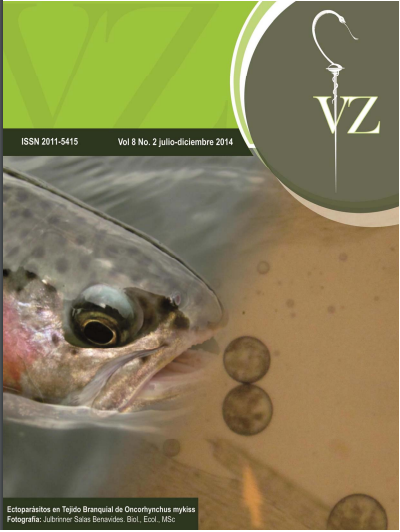Authors
Abstract
ABSTRACT: Bovine neonatal diarrhea is a disease, with etiology that can be infectious or non-infectious, which affects calves during the first three and causes serious economic losses in the dairy industry worldwide. This study describes the disease in a dairy herd in the Northern Antioquia Highlands. A cohort of 60 calves was evaluated during the first month of life through clinical examinations, haematological and serology analysis, and ELISA in fecal samples to detect Cryptosporidium parvum,bovine rotavirus type A, bovine coronavirus and E. coli K99. Additionally, the concentration of immunoglobulin in the colostrum administered and the passive transfer of immunoglobulin were estimated. Proportions of morbidity because of diarrhea were 94.92%, general mortality 17.58%, and lethality 15.79%.Among the group of sick animals 89.47%, 47.37%, 7.02% and 0% were found for each pathogenic agent respectively. A high percentage of animals with reactive lymphocytes were observed which indicates parasitic or viral infection. The results obtained from this study suggest that circulation of agents involved in bovine neonatal diarrhea can exist in the area, which generates concern because of the unknown sanitary status in the Northern Antioquia Highlands.
References
Aguirre, S.A. Elaboración de un manual para la crianza de terneras y para vaconas medias, fierros y vientres destinadas a la producción de leche orgánica. Quito,Ecuador: Universidad Central de Ecuador, 2012. 102p. Tesis (Ingeniera Agrónoma).
Avendaño, C.; Quílez, J.; Sánchez‐Acedo, C. Prevalencia de Cryptosporidium en terneros en el Valle de Ubaté ‐ Chiquinquirá (Colombia). Revista UDCA Actualidad & Divulgación Científica, v.13, n.1, p.41‐7, 2014.
Baquero‐Parrado, J.R. Diarrea neonatal indiferenciada: consideraciones sobre su prevención en campo, Veterinaria y Zootecnia, v.2, n.2, p.59‐68, 2008.
Baumgartner, W. Diarrhoea in calves and young cattle. Lucrări Ştiințifice – Seria Zoo Bicknell, E.J.; Noon, T.H. Animal Care and Health Maintenance. Neonatal Calf Diarrhea. USA: University of Arizona, 1993.
Boileau, M.J.; Kapil, S. Bovine coronavirus associated syndromes. Veterinary Clinics of North America: Food Animal Practice, v.26, n.1, p.123‐46, 2010.
Cho, Y.I.; Han, J.I.; Wang, C. et al. Case‐control study of microbiological etiology associated with calf diarrhea. Veterinary Microbiology, v.166, n.3‐4, p.375‐85, 2013.
Cho, Y.I.;Yoon, K.J. An overview of calf diarrhea‐infectious etiology, diagnosis, and intervention. Journal of Veterinary Science, v.15, n.1, p.1‐17, 2014.
Escobar, A.; Oliver, O. Factores de manejo que afectan la morbilidad y mortalidad en terneros durante sus primeros tres meses de vida en el Municipio de San Pedro de los Milagros, departamento de Antioquia. Bogotá, Colombia: Universidad Nacional de Colombia, 1997. Tesis (Medicina Veterinaria).
Ganaba, R.; Bigras‐Poulin, M.; Fairbrother, J.M. et al. Importance of Escherichia coli in young beef calves from northwestern Quebec. Canadian Journal of Veterinary Research, v.59, n.1, p.20‐5, 1995.
García, J.; Albornoz, O.; Vela, D. Determinación de inmunoglobulinas séricas de origen calostral en terneros recién nacidos. Boletín Técnico 6, Serie Zoológica, p.77‐85, 2006.
Harp, J.A.; Franklin, S.T.; Goff, J.P. et al. Effects of Cryptosporidium parvum infection on lymphocyte phenotype and reactivity in calves. Veterinary Immunology and Immunopathology, v.44, n.2, p.197‐207, 1995.
Hernández, N. Prevalencia y factores de riesgo de Cryptosporidium spp. y Giardia spp. en terneros de ganado lechero de la zona noroccidental de la sabana de Bogotá. Bogotá, Colombia: Universidad Nacional de Colombia, 2010. Tesis (Maestría en Salud Pública).
Holdridge, L.R. Life zone ecology. San José, Costa Rica: Tropical Science Center; 1967. 149p.
Lundborg, G.K.; Svensson, E.C.; Oltenacu, P.A. Herd‐level risk factors for infectious diseases in Swedish dairy calves aged 0‐90 days. Preventive Veterinary Medicine, v.68, n.2‐4, p.123‐43, 2005.
Malik, S.; Kumar, A.; Kumar‐Verma, A. et al. Haematological profile and blood chemistry in diarrhoeic calves affected with collibacillosis. Journal of Animal Health Production, v.1, n.1, p.10‐14, 2013.
Pardo, D.P. Determinación de los factores de riesgo y de los agentes etiológicos asociados con la presentación de diarrea neonatal bovina (DNB) en fincas de la sabana de Bogotá. Bogotá, Colombia: Universidad Nacional de Colombia, 2012. Tesis (Maestría en Salud Animal).
Trotz‐Williams, L.A.; Leslie, K.E.; Peregrine, A.S. Passive immunity in Ontario dairy calves and investigation of its association with calf management practices. Journal of Dairy Science, v.91, n.10, p.3840‐3849, 2008.
Trotz‐Williams, L.A.; Wayne, S.; Leslie, K.E. et al. Calf‐level risk factors for neonatal diarrhea and shedding of Cryptosporidium parvum in Ontario dairy calves. Preventive Veterinary Medicine, v.82, n.1‐2, p.12‐28, 2007.
Von Buenau, R.; Jaekel, L.; Schubotz, E. et al. Escherichia coli Strain Nissle 1917: Significant Reduction of Neonatal Calf Diarrhea. American of Dairy Science Association, v.88, p.317‐323, 2005.
Wallace, M.M.; Jarvie, B.D.; Perkins, N.R. et al. A comparison of serum harvesting methods and type of refractometer for determining total solids to estimate failure of passive transfer in calves. Canadian Veterinary Journal, v.47, n.6, p.573‐5, 2006.
Weaver, D.M.; Tyler, J.W.; Marion, R.S. et al. Evaluation of assays for determination of passive transfer status in neonatal llamas and alpacas. Journal of American Veterinary Medical Association, v.216, n.4, p.559‐63, 2000a
Weaver, D.M.; Tyler, J.W.; VanMetre, D.C. et al. Passive transfer of colostral immunoglobulins in calves. Journal of Veterinary Internal Medicine, v.14, n.6, p.569‐ 77, 2000b.
Wyatt, C.R. Cryptosporidium parvum and mucosal immunity in neonatal cattle. Animal Health Research Reviews, v.1, n.1, p.25‐34, 2000.
Wyatt,C.R.; Riggs, M.W.; Fayer, R. Cryptosporidiosis in neonatal calves. Veterinary Clinical of North America:Food Animal Practice, v.26, n.1, p.89‐103, 2010

 PDF (Español)
PDF (Español)
 FLIP
FLIP










